Picture this: You’re sitting in a quiet Japanese restaurant, the kind where the chef works with laser focus behind the counter. He takes a pristine fillet of tuna, glides his knife through it like butter, and places the perfect slice of sashimi on a minimalist plate. No rice, no sauces drowning the fish—just pure, unadulterated freshness.
Sashimi isn’t just about eating raw fish; it’s an art form, a tradition, and a test of culinary skill. But here’s the best part: You don’t need to be a sushi master to make sashimi at home! With the right ingredients, techniques, and safety measures, you can create restaurant-quality sashimi right in your own kitchen.
In this guide, you’ll learn:
✔️ What makes sashimi different from sushi
✔️ The best ingredients for homemade sashimi
✔️ Step-by-step instructions for preparing sashimi like a pro
✔️ Common mistakes and how to fix them
✔️ The best pairings for an unforgettable sashimi lunch
Ready? Let’s dive into the world of fresh, delicate, and delicious sashimi!
Table of Contents
What is Sashimi? Understanding the Japanese Delicacy
Before we start slicing, let’s get one thing straight: Sashimi is NOT sushi. Many people confuse the two, but there’s a key difference:
Sashimi is thinly sliced raw fish or seafood, served without rice.
Sushi, on the other hand, includes vinegared rice and sometimes seaweed. While sushi can feature raw fish, it’s the rice that defines it.
A Brief History of Sashimi
Sashimi dates back to the Heian period (794–1185 AD) in Japan, when fishermen began eating raw fish straight from their catch. Over centuries, this evolved into the precise knife skills and presentation techniques we see today.
Japanese chefs train for years to master “kiru”, the slicing technique that determines sashimi’s texture and taste. But don’t worry—you don’t need years of training to make great sashimi at home.
The Difference Between Sashimi and Sushi
Still wondering how sashimi stacks up against sushi? Here’s a simple comparison:
| Feature | Sashimi | Sushi |
|---|---|---|
| Definition | Raw fish or seafood, sliced and served alone | Vinegared rice with fish, seafood, or vegetables |
| Served With | Soy sauce, wasabi, pickled ginger | Rice, seaweed, fish, veggies |
| Main Focus | The freshness and quality of the fish | The balance of rice, fish, and toppings |
| Rice Included? | ❌ No | ✅ Yes |
So, if you’re all about pure, fresh seafood flavors, sashimi is the way to go!
Essential Ingredients for Making Sashimi
Making sashimi at home starts with choosing the right ingredients. Since you’ll be eating raw fish, quality and freshness are non-negotiable. If you’re looking for other ways to season fish, check out the best seasoning for fish to enhance the flavor of your sashimi without overpowering its delicate taste.
Choosing the Best Fish and Seafood for Sashimi
Not all fish is safe to eat raw. You need sashimi-grade fish, meaning it has been frozen at ultra-low temperatures to kill parasites.
Best Fish for Sashimi:
✅ Tuna (Maguro, Bluefin, Yellowfin, Albacore) – Buttery texture, rich taste
✅ Salmon (Sake) – Soft, fatty, and slightly sweet
✅ Hamachi (Yellowtail) – Mild, buttery, and firm
✅ Mackerel (Saba) – Strong flavor, perfect for seasoned eaters
✅ Sea Bream (Tai) – Delicate and slightly chewy
✅ Octopus (Tako) – Pre-boiled, firm, and slightly sweet
Fish to AVOID for Sashimi:
❌ Freshwater fish (e.g., tilapia, catfish) – Higher risk of parasites
❌ Non-sashimi-grade fish from the grocery store
Pro Tip: Buy from reputable fish markets or stores with a dedicated “sushi-grade” section.
Other Key Ingredients: Soy Sauce, Wasabi, and Garnishes
Besides fish, a few key ingredients enhance the sashimi experience:
- Soy Sauce (Shoyu): Adds umami depth
- Wasabi: A spicy kick that cleanses the palate
- Pickled Ginger (Gari): Refreshes the taste buds between bites
- Daikon Radish: Grated or julienned for a crunchy texture contrast
Can You Make Sashimi at Home?
Yes! But before you grab a knife, let’s talk about safety.
Safety Precautions for Handling Raw Fish
Raw fish can carry bacteria and parasites if not handled properly. Here’s how to stay safe:
✔️ Use only sashimi-grade fish – Never compromise on quality.
✔️ Keep fish refrigerated at all times (below 40°F or 4°C).
✔️ Use separate cutting boards for fish and other ingredients.
✔️ Freeze fish if unsure – Store at -4°F (-20°C) for at least 7 days.
How to Source High-Quality Sashimi-Grade Fish
Finding high-quality fish is half the battle. Here’s where to look: Want to take your seafood skills further? Learn how to season Louisiana fish fry and experiment with different flavors beyond sashimi.
- Japanese or Asian markets – They often have the best selection.
- Fishmongers or specialty seafood stores – Ask if it’s safe for raw consumption.
- Online seafood suppliers – Some deliver sashimi-grade fish straight to your door.
Nutrition Facts: Sashimi’s Health Benefits
Sashimi isn’t just delicious—it’s nutritious! Check out the nutritional profile per 100g of raw tuna sashimi:
| Nutrient | Amount |
|---|---|
| Calories | 130 kcal |
| Protein | 24g |
| Fat | 3g |
| Omega-3 | 800mg |
| Carbohydrates | 0g |
| Sodium | 40mg |
Why eat sashimi? It’s high in lean protein, omega-3 fatty acids, and essential vitamins, making it a perfect lunch choice!
How to Prepare Sashimi: Step-by-Step Guide
Now that you’ve got your sashimi-grade fish and essential ingredients, it’s time to roll up your sleeves and start slicing! But here’s the catch—sashimi isn’t just about cutting raw fish. The way you handle and present it affects its texture, flavor, and overall experience.
Let’s break it down step by step so you can prepare sashimi like a pro.
Tools and Equipment You Need
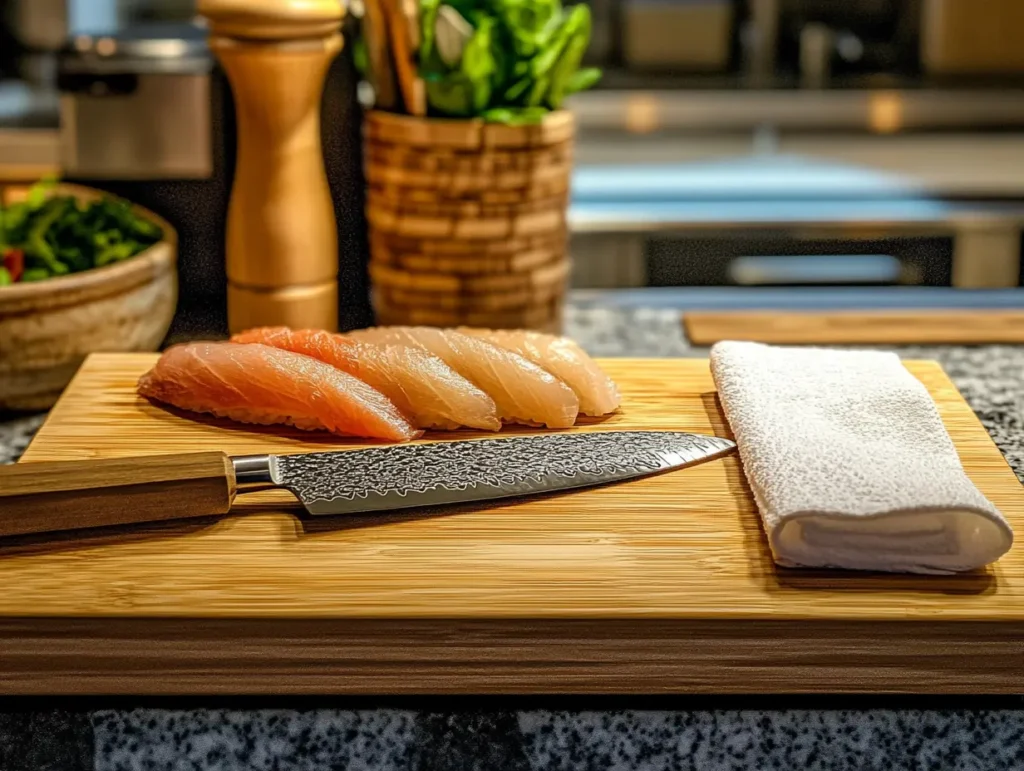
Before you start, make sure you have the right tools. Traditional Japanese chefs use specialized knives and boards to achieve precise cuts. Here’s what you’ll need:
| Tool | Purpose |
|---|---|
| Yanagiba Knife | A long, thin knife designed for slicing sashimi smoothly |
| Cutting Board | Preferably wooden, to absorb excess moisture |
| Tweezers | For removing tiny fish bones |
| Damp Towel | To wipe the knife between slices for clean cuts |
| Serving Plate | A chilled plate helps keep the sashimi fresh |
Pro Tip: If you don’t have a Yanagiba knife, a sharp chef’s knife will work. Just make sure it’s razor-sharp to avoid tearing the fish.
Proper Knife Techniques for Perfect Slices
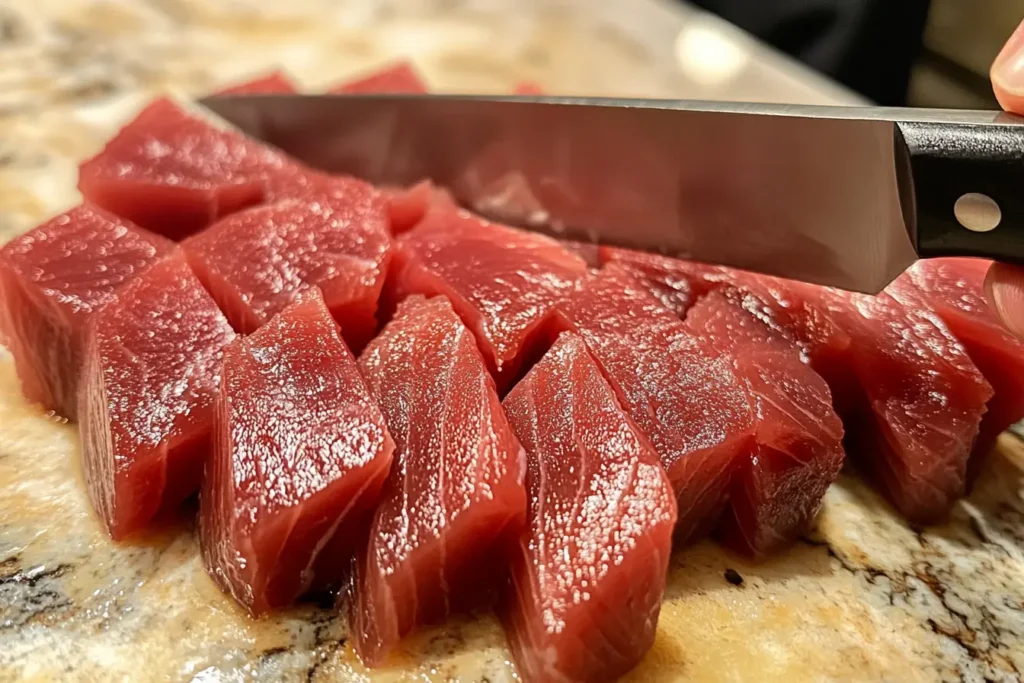
The secret to beautiful sashimi lies in how you slice it. Different fish require different cutting methods, and even the angle of the knife changes the texture of the fish.
Basic Cutting Techniques for Sashimi
- Sogigiri (Angled Cut)
- Used for softer fish like salmon and tuna.
- Hold the knife at a 45-degree angle and slice in one smooth motion.
- This exposes more surface area, making the fish look larger and more delicate.
- Hirazukuri (Rectangular Cut)
- Used for firm fish like yellowtail and sea bream.
- Cut the fish into thicker, rectangular slices (about ¼ inch thick).
- This method highlights the firm, meaty texture of the fish.
- Usuzukuri (Thin Cut)
- Best for delicate white fish like flounder.
- Slice as thin as possible for an elegant, almost translucent look.
- These are often arranged in a fan shape for presentation.
Avoid sawing the fish! Use a single, clean stroke to preserve texture and prevent tearing.
How to Plate and Serve Sashimi Like a Pro
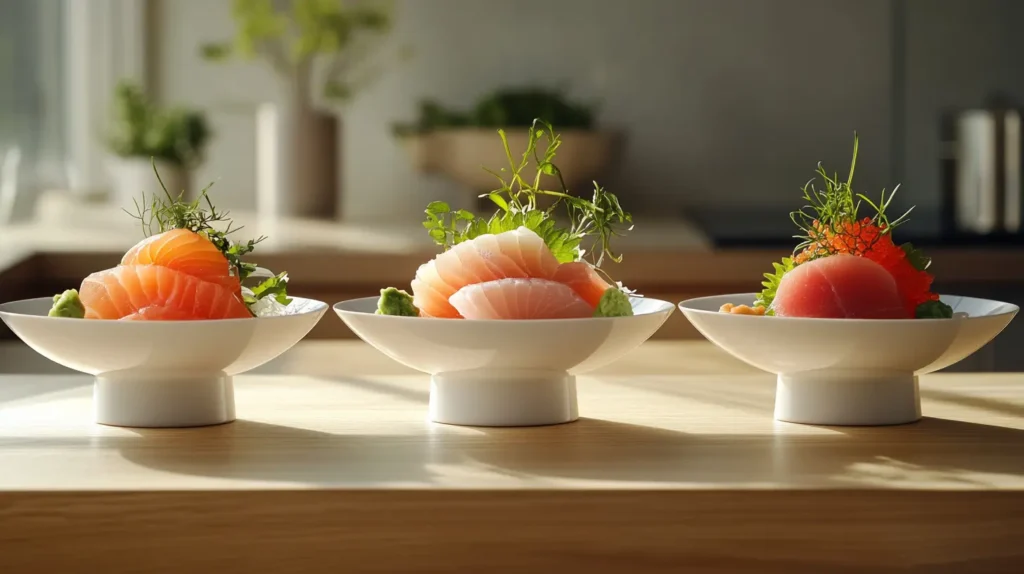
Sashimi isn’t just about taste—it’s a visual experience. Japanese chefs believe that presentation enhances flavor, so let’s make your sashimi plate look stunning.
Sashimi Plating Styles
- Traditional Japanese Style
- Arrange slices in a slight overlap, forming a fan shape.
- Add daikon radish and shiso leaves as garnish.
- Serve with soy sauce, wasabi, and pickled ginger on the side.
- Modern Minimalist
- Space out slices on a dark ceramic plate for contrast.
- Drizzle with a few drops of yuzu ponzu for a modern twist.
- Sashimi Tower
- Stack pieces in a pyramid for a high-end restaurant look.
- Use avocado, microgreens, or edible flowers for color contrast.
Pro Tip: Chill your serving plate in the fridge for 10 minutes before plating. This keeps the fish cool and fresh while serving.
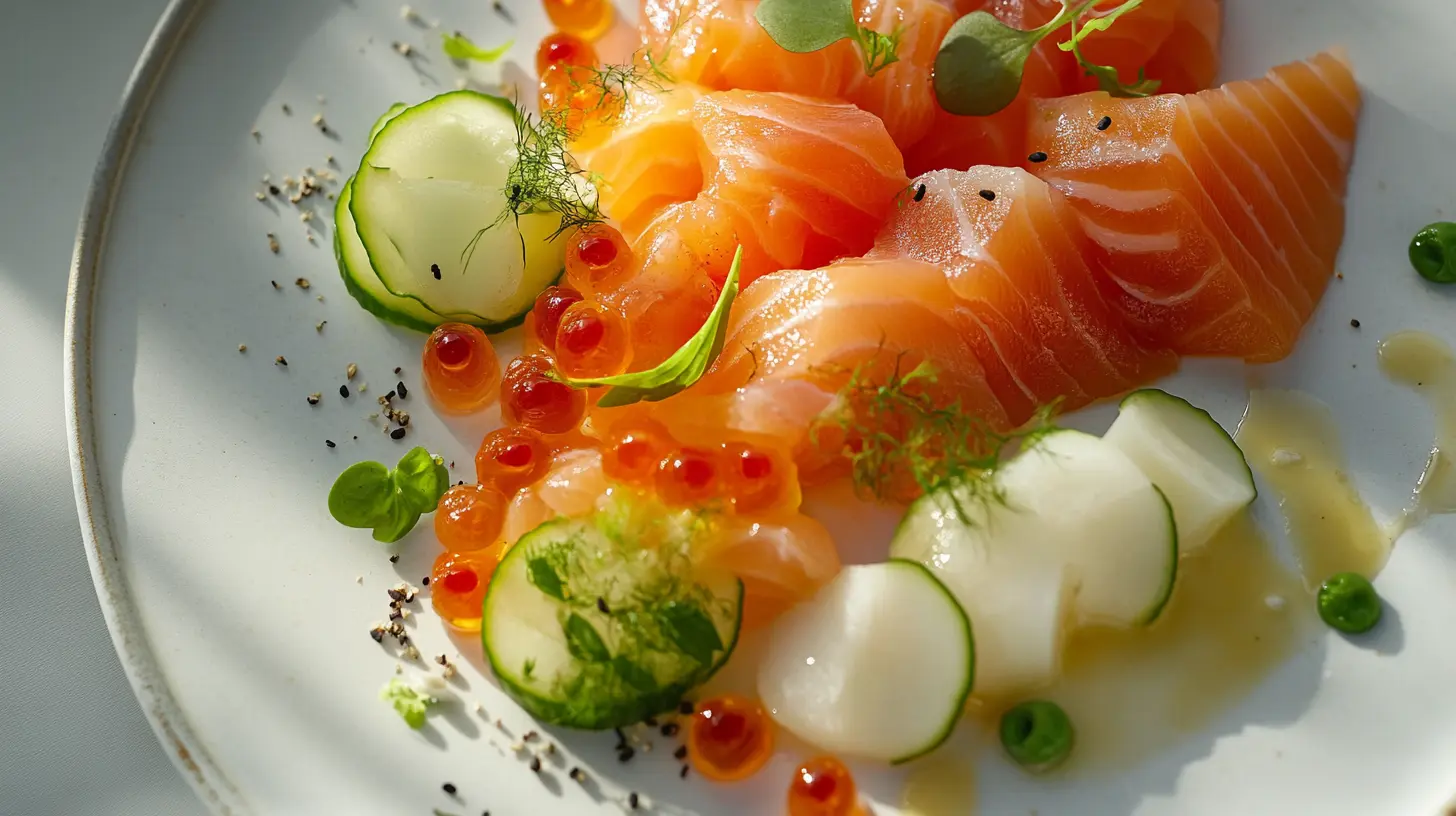
Sashimi
Ingredients
Method
- Ensure all tools are sanitized and ready, using separate cutting boards for sushi-grade fish.
- Use a sharp Yanagiba knife or a sharp chef's knife for slicing.
- Slice sashimi-grade fish into thin pieces, aiming for smooth, single strokes.
- Plate the sashimi elegantly, garnishing with daikon radish and pickled ginger.
- Serve immediately with soy sauce and wasabi.
Notes
What is Sashimi Marinated In? Exploring Different Marinades
While sashimi is traditionally served plain, some variations include light marinades that enhance flavor without overpowering the fish.
Traditional Japanese Marinades
✔ Shoyu Zuke (Soy Sauce Marinade)
- Perfect for tuna and salmon
- Enhances umami while keeping it simple
Recipe:
- 2 tbsp soy sauce
- 1 tsp mirin (sweet rice wine)
- 1 tsp sake
- ½ tsp sesame oil
How to Use:
- Dip sashimi slices into the marinade for 5–10 minutes, then serve.
✔ Yuzu Ponzu Marinade
- Best for white fish and octopus
- Light and citrusy, with a hint of tartness
Recipe:
- 3 tbsp ponzu sauce
- 1 tbsp yuzu juice (or lemon juice)
- ½ tsp grated ginger
How to Use:
- Let sashimi rest in the marinade for just 2 minutes before plating.
Modern Fusion Marinades for a Unique Twist
✔ Spicy Gochujang Marinade (Korean-Inspired)
- Works well with salmon or yellowtail
- Adds a slight kick of heat
Recipe:
- 1 tbsp gochujang (Korean chili paste)
- 1 tbsp soy sauce
- 1 tsp honey
- ½ tsp rice vinegar
✔ Truffle Soy Marinade (Luxury Upgrade)
- Pairs well with fatty tuna (Otoro)
- Earthy, rich, and decadent
Recipe:
- 2 tbsp soy sauce
- ½ tsp truffle oil
- 1 tsp chopped chives
Tip: When marinating sashimi, less is more—you want to enhance the natural taste of the fish, not overpower it.
Common Problems When Making Sashimi and How to Fix Them
Even seasoned chefs run into issues when preparing sashimi. Here’s how to avoid common mistakes.
Problem 1: Fish Tears While Slicing
Why It Happens:
❌ Using a dull knife
❌ Applying too much pressure
✅ Solution: Use a sharp knife and slice in one smooth motion without sawing.
Problem 2: Fish Doesn’t Taste Fresh
Why It Happens:
❌ Storing fish in the fridge for too long
❌ Buying low-quality seafood
✅ Solution: Always buy sashimi-grade fish and use it within 24 hours.
Problem 3: Cross-Contamination
Why It Happens:
❌ Using the same cutting board for raw fish and other foods
❌ Not cleaning knives between cuts
✅ Solution: Use separate tools and wipe knives between slices.
Best Sashimi Pairings for a Balanced Lunch
A plate of fresh sashimi is already a masterpiece on its own, but the right side dishes and condiments can take your meal to a whole new level. The key is to complement the delicate flavors of the fish without overpowering them.
Classic Side Dishes and Condiments
✔ Miso Soup – A warm, umami-rich broth that cleanses the palate between bites.
✔ Steamed Rice – A simple yet satisfying addition that balances the meal.
✔ Edamame – Lightly salted soybeans add a protein-packed crunch.
✔ Sunomono (Japanese Vinegared Cucumber Salad) – Refreshing and slightly tangy.
✔ Chuka Wakame (Seaweed Salad) – Brings a hint of sesame and ocean freshness.
Pro Tip: Stick to light, refreshing sides to keep the focus on the sashimi. Avoid heavy, greasy foods that might dull the fish’s natural taste.
Best Drinks to Complement Sashimi
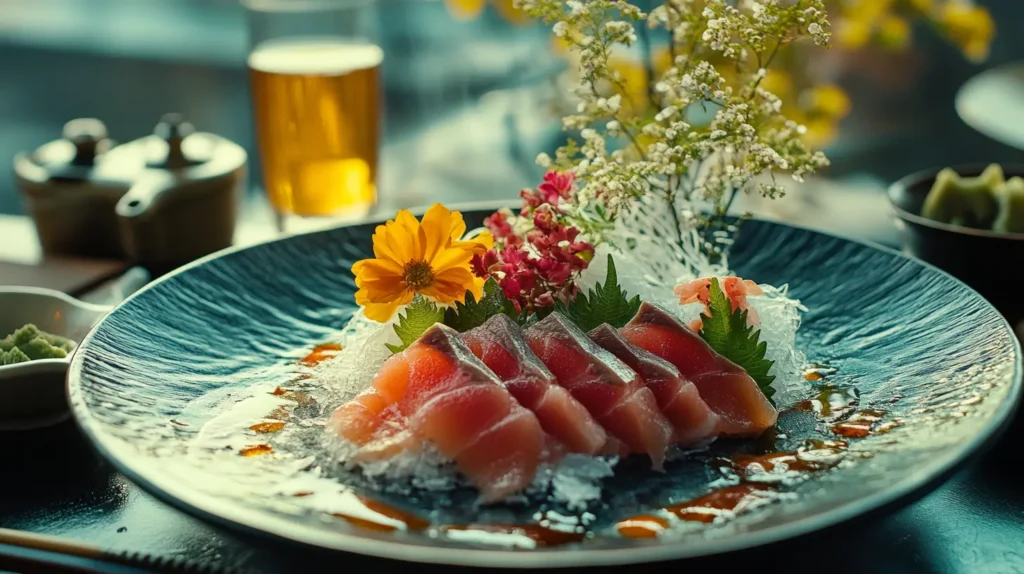
Pairing sashimi with the right drink enhances the flavors and creates a well-rounded meal. Whether you prefer traditional Japanese beverages or something more modern, here are the best options. If you love pairing meals with the perfect drink, you might enjoy this guide on the best way to cook diced chicken, which also includes great beverage pairings for different dishes.
Traditional Japanese Pairings
✅ Sake (Japanese Rice Wine)
- Pairs well with all types of sashimi, especially tuna and salmon.
- Choose a light, dry sake like Junmai Ginjo for a smooth, clean taste.
✅ Green Tea (Sencha or Genmaicha)
- Helps cleanse the palate between bites.
- Offers a slight bitterness that enhances the fish’s umami flavor.
✅ Shōchū (Japanese Distilled Spirit)
- A stronger alternative to sake with a nutty, earthy flavor.
- Best paired with richer fish like mackerel or fatty tuna.
Modern and Western Pairings
✅ Crisp White Wine (Sauvignon Blanc or Chardonnay)
- The acidity cuts through the fat in salmon and yellowtail.
✅ Japanese Beer (Asahi, Sapporo, Kirin)
- Light and refreshing, perfect for a casual sashimi lunch.
✅ Sparkling Water with Lemon
- A great non-alcoholic option that refreshes the palate.
Avoid heavy red wines or overly sweet drinks—they can overpower the subtle flavors of sashimi.
Frequently Asked Questions About Sashimi
Sashimi can seem intimidating if you’re new to making it at home. Here are answers to the most common questions to help you feel more confident.
What Are Sashimi Ingredients?
The core ingredients for sashimi include:
- Fresh, sashimi-grade fish (tuna, salmon, yellowtail, etc.)
- Soy sauce for dipping
- Wasabi for a touch of heat
- Pickled ginger to cleanse the palate
- Daikon radish for garnish
Depending on your personal preference, you can also add:
- Ponzu sauce (for a citrusy kick)
- Sesame seeds (for texture)
- Chopped green onions (for freshness)
Tip: Always source high-quality fish—this is the most important part of making sashimi!
Can I Make Sashimi at Home?
Yes! Making sashimi at home is completely doable if you follow the right steps:
✔ Buy sashimi-grade fish from a trusted supplier.
✔ Use a sharp knife to make clean slices.
✔ Follow proper food safety guidelines to prevent contamination.
✔ Serve immediately for the freshest experience.
Remember: Never use regular grocery store fish unless it’s specifically labeled as safe for raw consumption.
What is Sashimi Marinated In?
Traditional sashimi is often served plain, but it can be lightly marinated in:
- Soy sauce and mirin (for a sweet-savory balance)
- Ponzu sauce (for a citrusy touch)
- Truffle soy sauce (for an upscale twist)
However, avoid over-marinating—too much sauce can overpower the delicate taste of the fish.
How Do They Make Sashimi?
Sashimi is made by carefully slicing raw fish into thin, precise pieces. The process includes:
- Selecting the right fish – Only sashimi-grade seafood is used.
- Trimming and cleaning – Removing skin, bones, and imperfections.
- Slicing with precision – Using single, smooth strokes to maintain texture.
- Plating elegantly – Arranging pieces with attention to presentation.
Tip: Practice makes perfect! Start with softer fish like salmon before moving on to firmer fish that require more skill.
Conclusion: Enjoying Homemade Sashimi with Confidence
Making sashimi at home is an exciting and rewarding experience. It’s more than just a meal—it’s an art form that celebrates freshness, precision, and simplicity.
Here’s what you’ve learned:
✔ What sashimi is and how it differs from sushi
✔ How to choose the best sashimi-grade fish
✔ Step-by-step slicing and plating techniques
✔ The best marinades and pairing options
✔ How to avoid common mistakes
Now, it’s time to put your skills to the test! Whether you’re making a simple plate for yourself or preparing a stunning sashimi platter for guests, you now have the knowledge and confidence to do it right.
So, grab your knife, choose your favorite fish, and start creating your own sashimi masterpieces!
Have questions or want to share your sashimi experience? Drop a comment below—we’d love to hear from you!
Final Nutrition Facts: What Makes Sashimi a Healthy Choice?
Sashimi isn’t just delicious—it’s packed with lean protein, healthy fats, and essential nutrients. Curious about other healthy seafood options? Take a look at this guide on langostino tails to explore another delicious seafood dish.
Here’s a look at the nutrition per 100g of sashimi-grade tuna:
| Nutrient | Amount |
|---|---|
| Calories | 130 kcal |
| Protein | 24g |
| Fat | 3g |
| Omega-3 Fatty Acids | 800mg |
| Carbohydrates | 0g |
| Sodium | 40mg |
Why is sashimi great for lunch?
- High in protein – Keeps you full and supports muscle growth.
- Rich in omega-3s – Good for heart and brain health.
- Low in calories – Perfect for a light yet satisfying meal.
